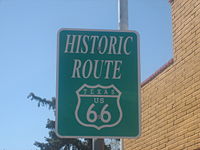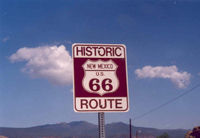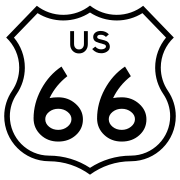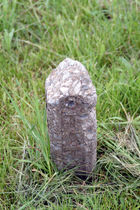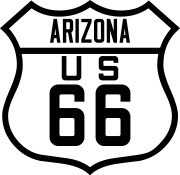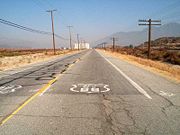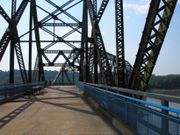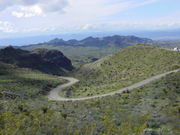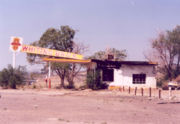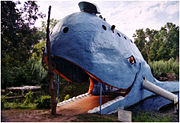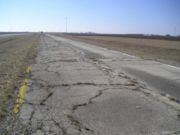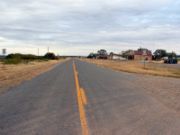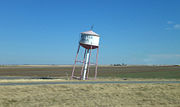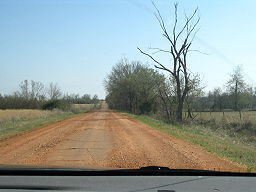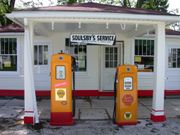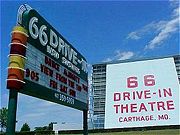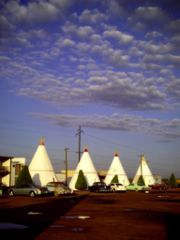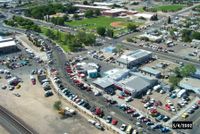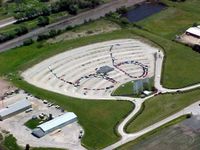U.S. Route 66
2008/9 Schools Wikipedia Selection. Related subjects: North American Geography; Road transport
 |
|||||||||
| U.S. Route 66 |
|||||||||
| Will Rogers Highway | |||||||||
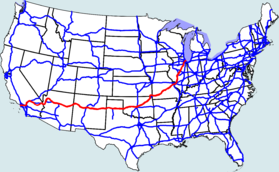 |
|||||||||
| Length: | 2450 mi (3943 km) | ||||||||
|---|---|---|---|---|---|---|---|---|---|
| Existed: | November 11, 1926 – June 27, 1985 | ||||||||
| West end: | Colorado Blvd. in Pasadena, CA (1964-1974) |
||||||||
| East end: | Lake Shore Drive in Chicago, IL (1926-1976) |
||||||||
|
|||||||||
|
U.S. Route 66
|
|||||||||
U.S. Route 66 (also known as Route 66, U.S. Highway 66, The Main Street of America, The Mother Road and the Will Rogers Highway) was a highway in the U.S. Highway system. One of the original federal routes, US 66 was established on November 11, 1926, though signs did not go up until the following year. It originally ran from Chicago, Illinois, through Missouri, Kansas, Oklahoma, Texas, New Mexico, Arizona, and California, before ending at Los Angeles for a total of 2,448 miles (3,940 km).
Route 66 underwent many improvements and realignments over its lifetime that changed its overall length. One of these realignments moved the western endpoint from downtown Los Angeles to Santa Monica. Contrary to common belief, Route 66 never ran to the coast; it terminated onto what was at the time US-101 ALT, at what is today the intersection of Olympic Boulevard and Lincoln Boulevard (a segment of State Route 1). It never went to the intersection of Ocean Boulevard and Santa Monica Boulevard, even though there is a plaque dedicating Route 66 as the Will Rogers Highway there.
Route 66 was a major path of the migrants who went west, especially during the Dust Bowl of the 1930s, and supported the economies of the communities through which the road passed. People doing business along the route became prosperous due to the growing popularity of the highway, and those same people later fought to keep the highway alive even with the growing threat of being bypassed by the new Interstate Highway System.
US 66 was officially decommissioned (that is, officially removed from the United States Highway System) on June 27, 1985 after it was decided the route was no longer relevant and had been replaced by the Interstate Highway System. Portions of the road that passed through Illinois, New Mexico, and Arizona have been designated a National Scenic Byway of the name "Historic Route 66". It has begun to return to maps in this form. Some portions of the road in southern California have been redesignated State Route 66, and others bear "Historic Route 66" signs.
Route description
Over the years, U.S. Route 66 received many nicknames. Right after Route 66 was commissioned, it was known as The Great Diagonal Way because a large section of the highway (Chicago to Oklahoma City) ran diagonally, unlike the other highways. Later, Route 66 was advertised as The Main Street of America by the US Highway 66 Association to promote the highway. The title had also been claimed by supporters of U.S. Route 40, but the Route 66 group was more successful. In the John Steinbeck novel The Grapes of Wrath, the highway is called The Mother Road, the title that The Route most often receives today. Lastly, Route 66 was unofficially named The Will Rogers Highway by the U.S. Highway 66 Association in 1952. A plaque dedicating the highway to the humorist is still located in Santa Monica, California. There were more plaques like this; one can be found in Galena, Kansas. It was originally located on the Kansas-Missouri state line, but moved to the Howard Litch Memorial Park in 2001.
History
| Lengths | ||
|---|---|---|
| mi | km | |
| CA | 314 | 505 |
| AZ | 401 | 645 |
| NM | 487 | 784 |
| TX | 186 | 299 |
| OK | 432 | 695 |
| KS | 13 | 21 |
| MO | 317 | 510 |
| IL | 301 | 484 |
| Total in 1926 | 2448 | 3940 |
Before the U.S. Highway system
In 1857, Lt. Edward Fitzgerald Beale, a Naval officer in the service of the U.S. Army Topographical Corps, was ordered by the War Department to build a government-funded wagon road across the 35th Parallel. His secondary orders were to test the feasibility of the use of camels as pack animals in the southwestern desert. This road became part of U.S. Route 66.
Before a nationwide network of numbered highways was adopted by the states, named auto trails were marked by private organizations. The route that would become Route 66 was covered by three highways. The Lone Star Route passed through St. Louis on its way from Chicago to Cameron, Louisiana, though US 66 would take a shorter route through Bloomington rather than Peoria. The transcontinental National Old Trails Road led via St. Louis to Los Angeles, but was not followed until New Mexico; instead US 66 used one of the main routes of the Ozark Trails system, which ended at the National Old Trails Road just south of Las Vegas, New Mexico. Again, a shorter route was taken, here following the Postal Highway between Oklahoma City and Amarillo. Finally, the National Old Trails Road became the rest of the route to Los Angeles.
Birth and rise of Route 66
Championed by Tulsa, Oklahoma businessman Cyrus Avery when the first talks about a national highway system began, US 66 was first signed in 1927 as one of the original U.S. Highways, although it was not completely paved until 1938. Avery was adamant that the highway have a round number and had proposed number 60 to identify it. A controversy erupted over the number 60, largely from delegates from Kentucky which wanted a Virginia Beach–Los Angeles highway to be US 60 and US 62 between Chicago and Springfield, Missouri. Arguments and counter-arguments continued and the final conclusion was to have US 60 run between Virginia Beach, Virginia, and Springfield, Missouri, and the Chicago–L.A. route be US 62. Avery settled on "66" (which was unassigned) because he thought the double-digit number would be easy to remember as well as pleasant to say and hear.
After the new federal highway system was officially created, Avery called for the establishment of the U.S. Highway 66 Association to promote the complete paving of the highway from end to end and to promote travel down the highway. In 1927, in Tulsa, Oklahoma, the association was officially established with John T. Woodruff of Springfield, Missouri elected the first president. In 1928, the association made its first attempt at publicity, the " Bunion Derby", a footrace from Los Angeles to New York City, of which the path from Los Angeles to Chicago would be on Route 66. The publicity worked: several dignitaries, including Will Rogers, greeted the runners at certain points on the route. The association went on to serve as a voice for businesses along the highway until it disbanded in 1976.
Traffic grew on the highway because of the geography through which it passed. Much of the highway was essentially flat and this made the highway a popular truck route. The Dust Bowl of the 1930s saw many farming families (mainly from Oklahoma, Kansas, and Texas) heading west for agricultural jobs in California. Route 66 became the main road of travel for these people, often derogatorily called " Okies". And during the Depression, it gave some relief to communities located on the highway. The route passed through numerous small towns, and with the growing traffic on the highway, helped create the rise of mom-and-pop businesses (mainly as service stations, restaurants, and motor courts) up and down the highway.
Much of the early highway, like all the other early highways, was gravel or graded dirt. Because of the efforts of the US Highway 66 Association, Route 66 became the first highway completely paved in 1938. Several places were dangerous: more than one part of the highway was nicknamed "Bloody 66" and gradually work was done to realign these segments to remove dangerous curves. However, one section (through the Black Mountains of Arizona) was fraught with sharp hairpin turns and was the steepest along the entire routes, so much so that some early travelers, too frightened at the prospect of driving such a potentially dangerous road, hired locals to navigate the winding grade. The section remained until 1953, but Route 66 continued to be a popular route despite such hazards.
During World War II, more migration west occurred because of war-related industries in California. Route 66, already popular and fully paved, became one of the main routes and also served for moving military equipment. Fort Leonard Wood in Missouri was located near the highway, which was locally upgraded quickly to a divided highway to help with military traffic. When Richard Feynman was working on the Manhattan Project at Los Alamos, he used to travel the nearly 100 miles (160 km) to visit his wife, who was dying of tuberculosis, in a sanatorium located on Route 66 in Albuquerque.
In the 1950s, Route 66 became the main highway for vacationers heading to Los Angeles. The road passed through the Painted Desert and near the Grand Canyon. Meteor Crater in Arizona was another popular stop. This sharp rise in tourism in turn gave rise to a burgeoning trade in all manner of roadside attractions including teepee-shaped motels, frozen custard stands, Indian curio shops, and reptile farms. Meramec Caverns near St. Louis began advertising on barns, billing itself as the " Jesse James hideout". The Big Texan advertised a free 72-ounce steak dinner to anyone who could eat the whole thing in an hour. It also marked the birth of the fast-food industry: Red's Giant Hamburgs in Springfield, Missouri, site of the first drive-through restaurant, and the first McDonald's in San Bernardino, California. Changes like these to the landscape further cemented 66's reputation as a near-perfect microcosm of the culture of America, now linked by the automobile.
Changes in routing
Many sections of US 66 underwent major realignments.
- In 1930, between Springfield and East St. Louis, Illinois, US 66 was shifted further east to what is now roughly I-55. The original alignment followed the current Illinois Route 4.
- From downtown St. Louis to Gray Summit, Missouri, US 66 originally went down Market Street and Manchester Road (now, largely, Route 100). In 1932, this route was changed, the original alignment never being viewed as anything more than temporary. The planned route was down Watson Road (now Route 366), but Watson Road had not yet been completed.
- From west of El Reno, Oklahoma, to Bridgeport, Oklahoma, US 66 turned north to Calumet, Oklahoma, and then west to Geary, Oklahoma, then southwest across the South Canadian River over a suspension toll bridge into Bridgeport, Oklahoma. In 1933, a straighter cut-off route was completed from west of El Reno directly to a point one mile (1.6 km) south of Bridgeport, crossing over a 38-span steel pony truss bridge over the South Canadian River and bypassing both Calumet and Geary by several miles.
- In 1936 Route 66 was extended from downtown Los Angeles to Santa Monica.
- From west of Santa Rosa, New Mexico, to north of Los Lunas, New Mexico, the road originally turned north from current I-40 along much of what is now US 84 to near Las Vegas, New Mexico, followed (roughly) I-25 through Santa Fe and Albuquerque to Los Lunas and then turned northwest along the present State Highway 6 alignment to a point near Laguna. In 1937, a straight-line route was completed from west of Santa Rosa through Moriarty and east-west through Albuquerque and west to Laguna. This newer routing saved travelers as much as four hours of travel through New Mexico.
- In 1940 the first freeway in Los Angeles was incorporated into Route 66: The Arroyo Seco Freeway.
- Since the 1950s, as interstates were constructed, sections of Route 66 not only saw the traffic drain to those interstates, but often the name itself was moved to the faster means of travel. In some cases such as to the east of St. Louis this was done as soon as the interstate was finished to the next exit.
Also, US 66 was rerouted around several larger cities via bypass or beltline routes to permit travelers to avoid city traffic congestion. Some of those cities included Springfield, Illinois; St. Louis, Missouri; Springfield, Missouri; Joplin, Missouri; and Oklahoma City, Oklahoma.
Decline
The beginning of the end for Route 66 came in 1956 with the signing of the Interstate Highway Act by President Dwight Eisenhower. As a general fighting in the European theatre during World War II, Eisenhower was impressed by Germany's high-speed roadways, (themselves influenced by the US highway system) or Autobahnen. Eisenhower envisioned a similar system of roads for the US in which one could conceivably drive at high speed from one end of the country to the other without stopping, as well as making it easier to mobilize troops in the event of a national emergency.
During its nearly 60-year existence, Route 66 was under constant change. As highway engineering became more sophisticated, engineers constantly sought more direct routes between cities and towns. Increased traffic led to a number of major and minor realignments of US 66 through the years, particularly in the years immediately following World War II when Illinois began widening US 66 to four lanes through virtually the entire state from Chicago to the Mississippi River just east of St. Louis, Missouri, and included bypasses around virtually all of the towns. By the early-to-mid 1950s, Missouri also upgraded its sections of US 66 to four lanes complete with bypasses. Most of the newer four-lane 66 paving in both states was upgraded to freeway status in later years.
One of the remnants of Route 66 is the highway now known as Veterans Parkway, east and south of Normal, Illinois, and Bloomington, Illinois. The two sweeping curves on the southeast and southwest of the cities originally were intended to easily handle traffic at speeds up to 100 miles per hour, as part of an effort to make Illinois 66 an Autobahn equivalent for military transport.
In 1953, the first major bypassing of US 66 occurred in Oklahoma with the opening of the Turner Turnpike between Tulsa and Oklahoma City. The new 88-mile (142 km) toll road paralleled US 66 for its entire length and bypassed each of the towns along 66. The Turner Turnpike was joined in 1957 by the new Will Rogers Turnpike, which connected Tulsa with the Oklahoma-Missouri border west of Joplin, Missouri, again paralleling US 66 and bypassing the towns in northeastern Oklahoma in addition to the entire state of Kansas. Both Oklahoma turnpikes were soon designated as Interstate 44, along with the US 66 bypass at Tulsa that connected the city with both turnpikes.
In some cases, such as many areas in Illinois, the new interstate highway not only paralleled the old Route 66, it actually incorporated much of it. A typical approach was to build one new set of lanes, then move one direction of traffic to it, while retaining the original road for traffic flowing in the opposite direction. Then a second set of lanes for traffic flowing in the other direction would be constructed, finally followed by abandoning the other old set of lanes or converting them into a frontage road.
The same scenario was used in western Oklahoma when US 66 was initially upgraded to a four-lane highway such as from Sayre through Erick to the Texas border at Texola in 1957 and 1958 where the old paving was retained for westbound traffic and a new parallel lane built for eastbound traffic (much of this section was entirely bypassed by I-40 in 1975), and on two other sections; from Canute to Elk City in 1959 and Hydro to Weatherford in 1960, both of which were upgraded with the construction of a new westbound lane in 1966 to bring the highway up to full interstate standards and demoting the old US 66 paving to frontage road status. In the initial process of constructing I-40 across western Oklahoma, the state also included projects to upgrade the through routes in El Reno, Weatherford, Clinton, Canute, Elk City, Sayre, Erick, and Texola to four-lane highways not only to provide seamless transitions from the rural sections of I-40 from both ends of town but also to provide easy access to those cities in later years after the I-40 bypasses were completed.
In New Mexico, as in most other states, rural sections of I-40 were to be constructed first with bypasses around cities to come later. However, some business and civic leaders in cities along US 66 were completely opposed to bypassing fearing loss of business and tax revenues. In 1963, the New Mexico Legislature enacted legislation that banned the construction of interstate bypasses around cities by local request. This legislation was short-lived, however, due to pressures from Washington and threat of loss of federal highway funds so it was rescinded by 1965. In 1964, Tucumcari and San Jon became the first cities in New Mexico to work out an agreement with state and federal officials in determining the locations of their I-40 bypasses as close to their business areas as possible in order to permit easy access for highway travelers to their localities. Other cities soon fell in line including Santa Rosa, Moriarty, Grants and Gallup although it wasn't until well into the 1970s that most of those cities would be bypassed by I-40.
By the late 1960s, most of the rural sections of US 66 had been replaced by I-40 across New Mexico with the most notable exception being the 40-mile (64 km) strip from the Texas border at Glenrio west through San Jon to Tucumcari, which was becoming increasingly treacherous due to heavier and heavier traffic on the narrow two-lane highway. During 1968 and 1969, this section of US 66 was often referred to by locals and travelers as "Slaughter Lane" due to numerous injury and fatal accidents on this stretch. Local and area business and civic leaders and news media called upon state and federal highway officials to get I-40 built through the area; however, disputes over proposed highway routing in the vicinity of San Jon held up construction plans for several years as federal officials proposed that I-40 run some five to six miles (10 km) north of that city while local and state officials insisted on following a proposed route that touched the northern city limits of San Jon. In November of 1969, a truce was reached when federal highway officials agreed to build the I-40 route just outside of the city, therefore providing local businesses dependent on highway traffic easy access to and from the expressway via the north-south highway that crossed old US 66 in San Jon. Interstate 40 was completed from Glenrio to the east side of San Jon in 1976 and extended west to Tucumcari in 1981, including the bypasses around both cities.
Originally, highway officials planned for the last section of US 66 to be bypassed by interstates in Texas, but as was the case in many places, lawsuits held up construction of the new interstates. The US Highway 66 Association had become a voice for the people who feared the loss of their businesses. Since the interstates only provided access via ramps at intersections, travelers could not pull directly off a highway into a business. At first, plans were laid out to allow (mainly national chains) to be placed in interstate medians. Such lawsuits effectively prevented this on all but toll roads. Some towns in Missouri threatened to sue the state if the US 66 designation was removed from the road, though lawsuits never materialized. Several businesses were well known to be on US 66, and fear of losing the number resulted in the state of Missouri officially requesting the designation "Interstate 66" for the St. Louis to Oklahoma City section of the route, but it was denied. In 1984, Arizona also saw its final stretch of highway decommissioned with the completion of Interstate 40 just north of Williams, Arizona. Finally, with decertification of the highway by the American Association of State Highway and Transportation Officials the following year, U.S. Route 66 officially ceased to exist.
With the decommissioning of US 66, no single interstate route was designated to replace it. Interstate 55 covered the section from Chicago to St. Louis; Interstate 44 carried the traffic on to Oklahoma City; Interstate 40 took the largest chunk, replacing 66 to Barstow, California; Interstate 15 took over for the route to San Bernardino; and Interstate 210 and State Route 2 or Interstate 10 carried Route 66's traffic across the Los Angeles metro area to Santa Monica.
After decertification
When the highway was decommissioned, sections of the road were disposed of in various ways. Within many cities, the route became a "business loop" for the interstate. Some sections became state roads, local roads, private drives, or were abandoned completely. Although it is no longer possible to drive Route 66 uninterrupted all the way from Chicago to Los Angeles, more than eighty percent of the original route and alternate alignments are still drivable with careful planning. Some stretches are quite well-preserved, including one between Springfield, Missouri, and Tulsa. Some sections of Route 66 still retain their historic eight-foot-wide "sidewalk highway" form, never having been resurfaced to make them into full-width highways.
Some states have kept the 66 designation for parts of the highway, albeit as state roads. In Missouri, Routes 366, 266, and 66 are all original sections of the highway. State Highway 66 in Oklahoma remains as the alternate "free" route near its turnpikes. A long segment in Arizona signed as State Route 66 links Seligman to Kingman. A surface street stretch between San Bernardino and La Verne (known as Foothill Boulevard) to the east of Los Angeles retains its number as State Route 66. Several county roads and city streets have also retained the "66" name.
Revival
In 1990, Route 66 associations were founded separately in both Arizona and Missouri. Other groups in the other Route 66 states soon followed. The same year, the state of Missouri declared Route 66 in that state a "State Historic Route". The first "Historic Route 66" marker was erected on Kearney Street at Glenstone Avenue in Springfield, Missouri (now replaced, the original sign has been placed at Route 66 State Park near Eureka). Other historic markers now line—at times sporadically—the entire 2,400 mile (3,860 km) length of road. There are instances in California, Kansas, and Oklahoma where the road surface itself has been painted with one of a number of similar symbols. Some of those symbols include:
- An outline of a federal highway shield with the number "66" and the state name, painted entirely in white.
- A black outline of the shield with the state also painted in black, but with the "66" painted in white.
- A solid white square with a shield outline, state name, and "66" painted in black over it.
- A solid white shield with patches of the pavement exposed to depict a horizontal line and the number "66" (and no other words).
A section of the road in Arizona was placed on the National Register of Historic Places; the Arroyo Seco Parkway in the Los Angeles Area and Route 66 in New Mexico have been made into National Scenic Byways; and in 2005, the State of Missouri made the road a state scenic byway from Illinois to Kansas. In the cities of Rancho Cucamonga, Rialto, and major city San Bernardino in California, there are US 66 signs erected along Foothill Boulevard and on Huntington Drive in the city of Arcadia. The city of Glendora, California renamed Alosta Avenue, its section of Route 66, by calling it Route 66. Flagstaff, Arizona renamed all but a few blocks of Sante Fe Avenue as Route 66.
Many preservation groups have also tried to save and even tried to landmark the old motels and neon signs along the road in different states.
In 2008, The World Monuments Fund named Route 66 to its World Monuments Watch list of 100 Most Endangered Sites. Sites along the route, such as gas stations, motels, cafes, trading posts, and drive-in movie theaters are threatened by development in urban areas, and by abandonment and decay in rural areas.
As the popularity and mythical stature of Route 66 has continued to grow, demands have begun to mount to improve signage, return Route 66 to road atlases and revive its status as a continuous routing. Along these lines Route 66 has been established as a National Scenic Byway in Illinois, Arizona and New Mexico with National Scenic Byway status pending in Oklahoma and Missouri as of 2007. Another move is also afoot that aims to reinstate Route 66 as an official U.S. Route. This initiative is however not supported by any Route 66 association nor by most preservationists, who claim it would destroy the character of Route 66 itself.
Route 66 and popular culture
- Route 66 gave its name to a company and also was immortalized in literature, popular music, and television. Although several businesses became associated with Route 66 because of their being on or near the highway, Phillips 66 actually took part of its name directly from the highway.
- Because the road through Oklahoma was relatively flat and straight, two chemical engineers decided to test a new gasoline from a Bartlesville oil company in the late 1920s. The company car they were driving ran exceptionally well on the new blend, prompting the engineer in the passenger seat to exclaim that the car was "going like sixty". His companion looked at the speedometer and said that they were going more like 66 miles per hour (106 km/h). The combination of the highway number and the speed of the car led to the naming of Phillips 66 gasoline, a brand still marketed today.
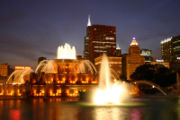
- In 1939, California writer John Steinbeck published The Grapes of Wrath, his novel about the westward migration of Oklahoma's Dust Bowl farmers to California's San Joaquin Valley. The book described the problems many of them faced, including prejudice and poverty, as they traveled to a hopefully better life. In this book, he spent a chapter describing the path west, which funnels to Oklahoma City and continues down Route 66. He referred to Route 66 as the "Mother Road", a nickname the highway still retains. The book won a Pulitzer Prize and made the road even more famous.
- In 1946, jazz composer and pianist Bobby Troup wrote his best-known song, " (Get Your Kicks On) Route 66", after driving the highway himself to get to California. He presented it to Nat King Cole who in turn made it one of the biggest hit singles of his career. The title was suggested by Troup's first wife, Cynthia, who accompanied him on the trip. The song later became a hit for Chuck Berry, and has been recorded by many subsequent artists, including The Rolling Stones, Herman Brood, The Cramps, Depeche Mode, John Mayer, The Manhattan Transfer with Oscar Peterson, Asleep at the Wheel, Buckwheat Zydeco, and Van Morrison.
- The highway also gave its name to a popular television show, Route 66, seen from 1960 through 1964 on CBS. The show featured Martin Milner and George Maharis as Tod Stiles and Buz Murdock, two young men in a Corvette looking for adventure along America's highways. Maharis was later replaced by Glenn Corbett, who played a returning Viet Nam vet named Linc. Strangely, though the entire program was filmed on location, it was rarely shot along Route 66. Since then, the Corvette has become the car most associated with Route 66. The theme song from the TV series, long a staple of General Motors advertising for the Corvette, was written and played by Nelson Riddle and his band. The show was clearly inspired by passages from Jack Kerouac's On the Road, which described several cross-country journeys in the 1940s.
- Another famous GM product has a strong connection to Route 66: The Cadillac Ranch, located near Amarillo, Texas, features a row of ten vintage Cadillacs standing up at an angle, with their front ends buried in the ground.
- An NBA Development League basketball team, the Tulsa 66ers, was named after the route. The road also lent its name to a minor league baseball team, the Inland Empire 66ers of San Bernardino in the city of San Bernardino.
- The country song "Is Anybody Going to San Antone" (recorded by Doug Sahm and Charley Pride, among others) includes the line: "Here I am walking up Sixty-Six/Wishing she hadn't done me that way."
- In the 1988 film Rain Man, Charlie and Raymond are believed to have traversed most of Route 66, which Charlie refers to as "some shit secondary road" -- departing from Cincinnati, Ohio and stopping in Missouri, Oklahoma, Las Vegas, and finally reaching Los Angeles.
- The highway was referred to as "the fabled Route 66" in Stacy Peralta's Dogtown and Z-Boys.
- The Disney/ Pixar movie Cars is set mainly in the fictional town of Radiator Springs, located on Route 66 and bypassed by I-40. Radiator Springs was based largely on Amboy, California, Seligman, Arizona and Galena, Kansas, actual Route 66 towns that saw a rapid decline when I-40 opened in the early 1970s. The film, which opened June 9, 2006, was originally titled Route 66, but had its name changed to avoid confusion with the 1960s-vintage TV show. Several familiar sites associated with Route 66 appear in the film, including a visual homage to the Cadillac Ranch, the U-Drop Inn in Shamrock, Texas, and the Wigwam motels in Holbrook, Arizona and on the border of San Bernardino and Rialto in California. The Mater character is based on an International Harvester tow truck that still sits next to The Route in Galena, Kansas. The Historic US 66 sign depicted in this film is the Arizona-specific version of the Historic US 66 sign.
- The U2 song "Heartland" from their album Rattle and Hum, references Route 66 with the lines, "66 a highway speaks, of deserts dry, of cool green valleys, gold and silver veins, all the shining cities."
- "The King of Route 66" is a video game that allows players to travel the route, competing in various competitions in trucks. A PlayStation version was released in 2003.
- The route was mentioned in the TV series Prison Break as a code in reference to the underground tunnels running parallel across the Fox River State Penitentiary.
- The movie National Lampoon's Vacation includes a scene (after the Griswolds leave Walley World to get a gun) in which they pass through the real-life western end of Route 66 in Santa Monica.
- The Indian Pop singer Lucky Ali shot one of his most famous music videos from his well received 1998 album Sifar on this route. The title of the song was "Dekha Hai Aise". The video featured the singer travelling on a Greyhound bus on this route.
Bannered routes
Several alternate alignments of US 66 occurred because of traffic issues. Business routes (BUS), bypass routes (BYP), alternate routes (ALT), and "optional routes" (OPT) (an early designation for alternate routes) came into being.
- U.S. Route 66 Alternate: Bolingbrook, IL– Gardner, IL
- U.S. Route 66 Business: Towanda, IL– Bloomington, IL
- U.S. Route 66 Business: Lincoln, IL
- U.S. Route 66 Business: Springfield, IL
- U.S. Route 66 Business: Mitchell, IL– East St. Louis, IL
- U.S. Route 66 Business: St. Louis, MO– Sunset Hills, MO
- U.S. Route 66 Optional: Venice, IL– St. Louis, MO
- U.S. Route 66 Bypass: Mitchell, IL– Sunset Hills, MO
- U.S. Route 66 Business: Springfield, MO
- U.S. Route 66 Bypass: Springfield, MO
- U.S. Route 66 Alternate Business: Springfield, MO
- U.S. Route 66 Alternate: Carthage, MO
- U.S. Route 66 Business: Carterville, MO– Webb City, MO
- U.S. Route 66 Alternate: Webb City, MO– Joplin, MO
- U.S. Route 66 Business: Joplin, MO
- U.S. Route 66 Bypass: Joplin, MO
- U.S. Route 66 Business: Tulsa, OK
- U.S. Route 66 Business: Oklahoma City, OK
- U.S. Route 66 Business: Clinton, OK
- U.S. Route 66 Business: Amarillo, TX
- U.S. Route 66 Business: San Bernardino, CA
- U.S. Route 66 Alternate: Pasadena, CA–Los Angeles, CA
